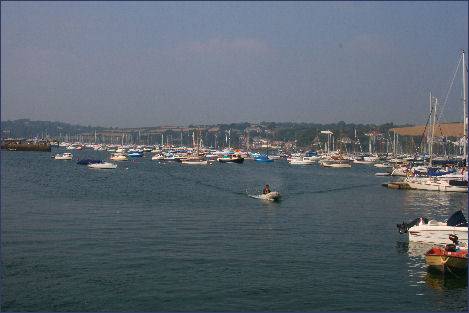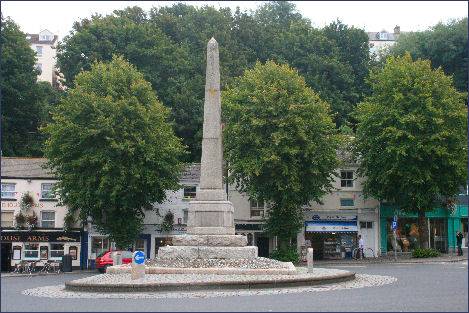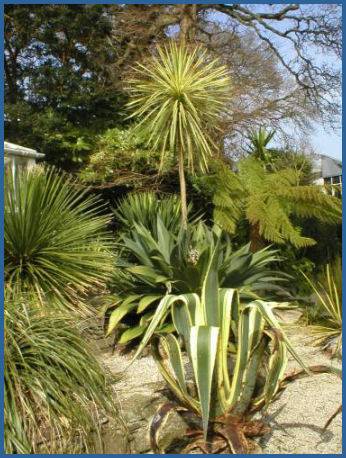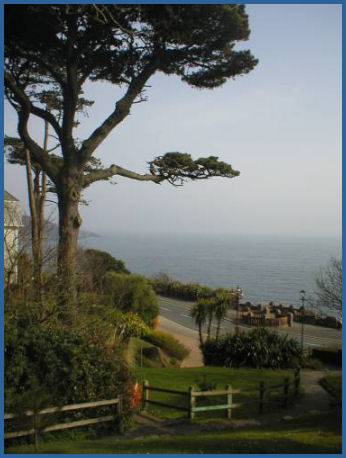Falmouth
OS Grid ref:- SW 810 325
The vibrant port of Falmouth on the Fal estuary was originally known as Smithwick and is one of south east Cornwall's main resorts. Falmouth, which is known in Cornish as Aberfala, is a popular holiday destination and it is now primarily a tourist resort. The town possesses four extensive golden beaches, Gyllyngvase, Swanpool, Castle and Maenporth.
Left- The River Fal Estuary at Falmouth and Right -Falmouth Maritime Monument


The town offers a wide range of accomodation from guest houses to hotels. As well as the usual chain High Street stores there are a multitude of craft shops and souvenir shops for the tourist.
Warmed by the Gulf Stream, Falmouth boasts many sub-tropical gardens including the Fox Rosehill Gardens, once owned by the Fox family, and now a public park. The two acre park offers magnolias, acacias and rhododendrons in addition to exotic species such as the Chilean firebush. Many varied species from Australia, New Zealand and South America have been successfully introduced to the mild Cornish climate at Fox Rosehill Gardens, including Lemon, Banana and Eucalyptus Trees, Bamboos, Agaves and a wide variety of Palms. The famous gardens of Trelissick, Glendurgan, Penjerrick, Gyllngdune and Trebah are all situated close by.
Fox Rosehill Gardens, and Gyllngdune, images courtesy of Cornish Garden Photos


Arwenack House opposite Discovery Quay was home to the Killigrew family for centuries. The name ‘Arwenack’, loosely translates as, ‘white water’. Originally built in 1385 and then largely rebuilt around 1567-1571 by Sir John Killigrew, the first Governor of Pendennis Castle. At that time it was described as 'the finest and most costly house in the country'.
Kenneth Grahame began his favourite children's book 'Wind in the Willows' while staying at Falmouth's Green Bank Hotel, proof of which is proudly displayed in the hotel's lobby. Poldark author Winston Graham set his novel The Forgotten Story (1945) in Falmouth.
Falmouth Harbour has amenities for various watersports, sailing and diving schools, equipment hire and fishing trips. Together with Carrick Roads, it forms the third deepest natural harbour in the world, and the deepest in Western Europe. The Ship and Castles Leisure Pool on Pendennis Headland has an exciting rapid river run and wave machine. At he far end of the town is situated the Georgian Custom House, which boasts an imposing facade with Greek Doric columns. Falmouth Maritime Museum is a small but highly interesting museum containing a wide variety of items covering Falmouth's long maritime history.
Falmouth Regatta Week, a popular tourist attraction, is held in July or August .
Pendennis Castle
Pendennis Castle occupies the headland of Pendennis Point and is now owned by English Heritage, it was built by King Henry VIII from 1540-1545, along with nearby St. Mawes Castle as a coastal defence at the entrance to the River Fal.
Click for more information on Pendennis Castle
Places to visit in Falmouth
Falmouth Maritime Museum hosts displays on Falmouth's nautical past. Model ships, photographs and chronicles of shipwrecks. The museum also owns thw 1929 stem tug, Denys, which is berthed in Falmouth harbour.
Falmouth Arts Centre has a wide programme of events, from theatre and films to exhibitions by local artists.
Falmouth Art Gallery exhibits work by Waterhouse and Tuke, amongst many other displays.
Pirates, Smugglers and Wreckers of Cornwall